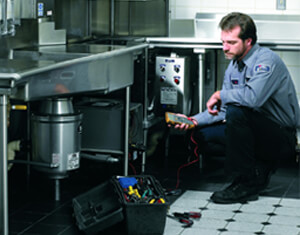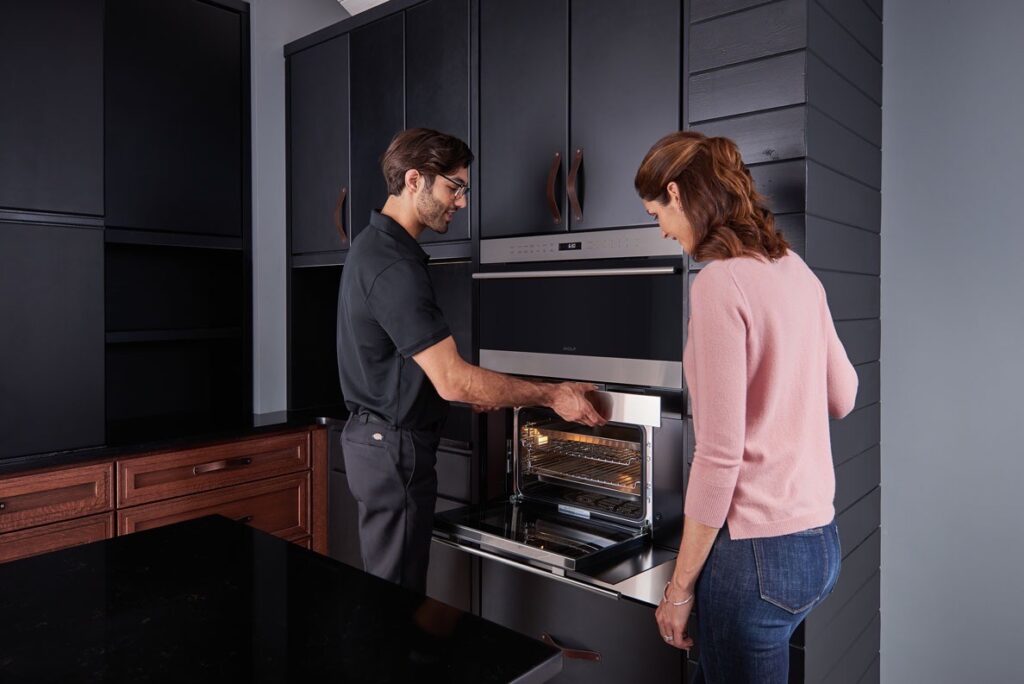The Ultimate Overview to DIY Home Appliance Repair Service Techniques
From refrigerators to dishwashing machines, comprehending just how to troubleshoot and repair these devices can save you time and cash. Are you ready to discover crucial methods that will equip you to deal with repairs with confidence?
Recognizing Common Appliance Troubles
When you rely on your home appliances, it can be frustrating when they instantly quit functioning or act up. Recognizing common appliance issues can aid you repair concerns efficiently.
If your oven isn't home heating, damaged elements or thermostat concerns could be at fault. Dishwashers usually experience troubles with water drainage, so see to it the filter is clean and the drain tube isn't kinked.
Also, listen for uncommon noises; they usually suggest mechanical concerns. By recognizing these indications, you can conserve time and possibly stay clear of costly repairs. A little knowledge goes a lengthy way in maintaining your home appliances, so stay informed to keep whatever running efficiently.
Crucial Devices for Do It Yourself Repair Works
Prior to diving right into do it yourself home appliance repair work, it is essential to collect the right tools to ensure the procedure goes smoothly. Beginning with a good set of screwdrivers, including both flathead and Phillips, as they're important for opening up most home appliances. You'll likewise want a set of pliers for grasping and turning cables or little parts.
Don't neglect a multimeter; it aids you test electrical elements and identify issues properly. An outlet set comes in handy for loosening or tightening up screws, while an energy blade can be valuable for cutting wires or opening up packaging.
Finally, think about having a flashlight handy to light up dark areas inside your appliances. With these important tools, you'll be well-appointed to tackle different repair work, conserving both time and cash. So, gather your equipment and obtain all set to roll up your sleeves!
Safety First: Preventative Measures to Take
Before you begin any kind of home appliance repair service, it's important to focus on safety and security. Make certain you put on individual protective devices, separate the source of power, and maintain your workspace arranged. These simple preventative measures can assist stop mishaps and guarantee a smoother repair work process.

Personal Protective Devices
Safety and security gear is a vital part of any type of DIY home appliance fixing project. You must constantly put on security goggles to protect your eyes from dirt and debris. A sturdy set of handwear covers will certainly shield your hands from sharp edges and unsafe products. Think about making use of a mask if you're taking care of chemicals or dirt, ensuring you take a breath securely while functioning. Steel-toed boots are additionally a smart choice, particularly when lifting hefty home appliances. Do not neglect to put on lengthy sleeves and pants to secure your skin from possible injuries. By prioritizing individual safety tools, you'll considerably decrease the threat of accidents and injuries. Remember, being prepared with the appropriate gear keeps you risk-free and concentrated on finishing your repair successfully.
Source Of Power Disconnection
To ensure a safe Do it yourself device repair work, detaching the power source is crucial. This simple step stops electrical shocks and guarantees that you can concentrate on the repair without stressing regarding accidental activation. Once you're confident that the power is detached, you can confidently proceed with your fixings, understanding you've taken the needed preventative measures to protect on your own.
Work Location Company
A well-organized work location can make all the distinction in your DIY appliance repair project. Begin by clearing your workspace of clutter to avoid interruptions and crashes. A tidy area not just enhances effectiveness but additionally keeps you risk-free while you function on your device repair.
Step-by-Step Overview for Fridge Repairs
When your refrigerator starts acting up, it can be irritating, but dealing with the problem yourself can save you money and time. First, unplug the refrigerator to guarantee security. Examine for common problems like temperature level changes or unusual noises. If it's not cooling, check the thermostat setups; they may be set as well high. Next, clean the condenser coils, which typically accumulate dirt and debris. For a noisy refrigerator, inspect the follower and confirm it's not blocked.
If there's water merging inside, check the door seals for damages or dirt, and tidy them if necessary. For ice buildup, clear the defrost drain. Connect the fridge back in and monitor it for a few hours once you've resolved the issue. If the trouble persists, you may require to change a defective part, like the compressor or follower electric motor. Keep in mind, don't hesitate to seek advice from the manual or look for professional help if required.
Repairing Cleaning Equipment Issues
Simply like refrigerators, washing equipments can present their very own collection of difficulties, yet many concerns can be settled with a little bit of troubleshooting. If your device will not start, inspect the power cable and validate it's connected in. Next off, examine the door lock; a faulty latch can prevent the cycle from beginning. If you notice unusual noises throughout operation, it might be because of international items embeded the drum or the drain pump.
If your clothes aren't obtaining tidy, take into consideration the water level and cleaning agent kind; making use of way too much cleaning agent can produce excess suds, impacting performance. For leakages, check out the pipes for fractures or loose connections. Tightening up these can often fix the trouble. Regular maintenance, like cleansing the filter, can protect against many problems from developing. Remember, a little troubleshooting goes a long method in keeping your cleaning device running efficiently.
Fixing Stoves and Ovens
Exactly how can you troubleshoot typical issues with your oven or range? Beginning by inspecting the power supply. Make sure it's connected in and the circuit breaker is not stumbled. If it's a gas oven, verify the gas valve is open. Next, test the burners: if they don't stir up, clean up the igniter and look for blockages in the burner ports.
If your oven isn't home heating, check the temperature level settings and verify the door seals firmly. If it's damaged., a malfunctioning home heating element could additionally be the offender; you may require to change it.
For irregular food preparation, rotate your pans and think about using a stove thermostat to confirm precise temperature levels. Ultimately, if you hear unusual sounds or odor gas, shut off the appliance promptly and speak with a my site specialist. By complying with these actions, you can determine and resolve many usual stove and stove concerns successfully.
Fixing Dishwashers Facilitated
When your dish washer begins breaking down, it can be aggravating, however addressing common concerns isn't as tough as it seems. You'll discover step-by-step troubleshooting techniques that will certainly aid you pinpoint the issue, along with the important tools you'll require to deal with repairs yourself. Allow's make fixing your dish washer a breeze!
Typical Dishwashing Machine Concerns
While dishwashers are made to make your life simpler, they can occasionally run into common concerns that leave you really feeling irritated. If your dishwasher's door won't latch, it can be an easy concern with the latch device or door seal. Dealing with these issues early can conserve you time and headache down the road.

Detailed Troubleshooting
Prior to diving into fixings, it's important to recognize the particular concern your dishwashing machine is facing. If it's not cleaning up correctly, Start by inspecting. Evaluate the spray arms for obstructions and guarantee they rotate easily. If it's leaking, take a look at door seals and pipes for any type of damage. For weird noises, listen very closely during cycles; foreign objects may be stuck in the filter or impeller. If your dishwashing machine won't start, inspect the power supply and door latch. Do not fail to remember to consult your user guidebook for troubleshooting tips certain to your version. By carefully dealing with each potential issue, you can pinpoint the problem and take the needed actions to fix it, making your dish washer feature like brand-new once more.
Important Repair Work Tools
Having the right tools at your disposal can make all the distinction when repairing your dishwashing machine. Don't fail to remember a pail or towels for any water splashes throughout repair services.
If you're dealing with blockages, a drain snake or a wet/dry vacuum cleaner will be important. You might additionally desire a degree to guarantee your dishwashing machine's appropriately aligned. Ultimately, security equipment like safety glasses and handwear covers will certainly safeguard you while you function. With these why not find out more crucial tools, you'll be well-equipped to tackle any dishwashing machine repair difficulty that comes your means.
Frequently Asked Questions
Exactly how Do I Establish if a Home Appliance Deserves Fixing?
To identify if a device's worth repairing, consider its age, repair service costs, and existing worth. You could want to invest in a brand-new version instead - Dependable Refrigeration Appliance SubZero repair near me. if repair services exceed half the substitute price.
Can I Locate Substitute Parts In Your Area for My Device?
Yes, you can commonly find substitute parts locally for your home appliance. Inspect hardware stores, home appliance repair stores, or local classifieds. Do not neglect to bring the model number to assure you get the proper component!
When Repairing Home Appliances?, what Common Mistakes Should I Stay Clear Of.
When fixing devices, stay clear of hurrying through diagnostics, neglecting security precautions, or utilizing wrong devices. Do not miss checking out handbooks or enjoying tutorials; they offer vital guidance. Be client and extensive to guarantee effective repair work and protect against further damages.
For how long Does a Typical Do It Yourself Home Appliance Fixing Take?
A normal do it yourself device repair work generally takes one to 3 hours, depending on the complexity. You'll wish to gather your devices and navigate to this website products initially, and follow instructions very carefully to stay clear of unnecessary delays.
Are There Any Warranties for Do It Yourself Home Appliance Repair Works?
When you tackle DIY appliance repair work, guarantees usually do not cover your job. Nevertheless, some producers could recognize guarantees for components you replace. Constantly check your home appliance's guarantee terms prior to starting any type of fixings to avoid problems.
Prior to diving right into Do it yourself device repair services, it's essential to gather the right devices to ensure the procedure goes smoothly.Prior to you start any device fixing, it's crucial to prioritize security.To guarantee a secure DIY device repair work, separating the power resource is important.An efficient work location can make all the distinction in your DIY device fixing project. Constantly inspect your device's service warranty terms before starting any kind of repairs to avoid issues.